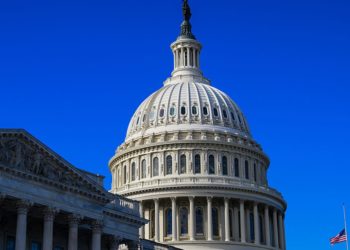The rate at which New York State has been adding millionaires to its population in recent years has fallen below that of other large states, potentially costing the state billions in unrealized tax revenue, according to a new report from a nonpartisan fiscal watchdog group.
At the same time, California, Florida and Texas had large increases in the number of people with annual incomes of at least $1 million residing in their states, all adding them at a faster rate than New York did from 2010 to 2022. The millionaire population in New York nearly doubled over that same time period, but it more than tripled in those other states.
The report, published on Thursday by the Citizens Budget Commission, comes at a time when the topic of millionaires in New York City, the taxes they pay and broader concerns about income inequality and affordability have been the most prominent themes in the race for mayor.
“We have a debate about affordability, but we need to raise more revenue,” said Andrew Rein, the president of the Citizens Budget Commission, “and we can raise even more revenue if we have even more millionaires.”
There were about 70,000 people earning $1 million in New York State in 2022, with half of them living in New York City, according to the report.
Mr. Rein said the timing of the report’s release, about nine weeks before Election Day, had not been influenced by politics or any campaign. The group’s trustees and its executive committee include officials from some of the largest corporations in the city. He said the commission has tracked the composition of New York earners and the state’s competitiveness for decades.
But the group’s arguments that New York City needs more millionaires and that any increase in personal income taxes could drive them away mirror positions held by two candidates, Mayor Eric Adams and former Gov. Andrew M. Cuomo, and is in opposition to the platform of Zohran Mamdani, a state assemblyman who is the Democratic nominee. Mr. Mamdani has proposed a new 2 percent tax on income greater than $1 million.
Mr. Rein said the population shift among millionaires reflected intensifying competition among states for people and companies. In addition to no new taxes, the group has called for deeper investments in quality-of-life areas like safety and parks during the next mayor’s administration.
While just 1 percent of the city’s taxpayers are millionaires, their contributions make up 40 percent of all personal income tax collected.
If New York’s rate of growth had kept pace with that of other states, the group said, the state and city would have together collected $13 billion in additional taxes in 2022, the most recent year of available data.
Emily Eisner, the chief economist at the nonpartisan Fiscal Policy Institute, said that the country’s distribution of millionaires was not a zero-sum game in which population shifts in other states was detrimental to New York State.
Over the past five years, she noted, New York State consistently collected more tax revenue than projected, driven by high wage growth among top earners.
Also, Ms. Eisner said the latest migration trends showed that millionaires were not leaving New York City and that, according to her research, they do not move in response to tax increases. Middle- and upper-middle class families — those in the $200,000 to $300,000 income range — are departing at the fastest rate, she said.
“The question is how is New York City and New York State doing, and the answer is that a lot of people are being priced out,” Ms. Eisner said, “and it’s not the millionaire class.”
Emerging from the worst of the coronavirus pandemic, the jobs created in New York City have been concentrated at opposite ends of the income spectrum, in low- and high-wage fields, while rents have continued to climb.
New York State added millionaire earners at a consistent rate from 2010 to 2022, when it had 69,780 tax filers with incomes greater than $1 million and about half lived in New York City. There were 35,802 millionaire filers in 2010 in New York State.
California stayed the top home for millionaires every year over that period, with an acceleration of top earners in recent years. It had 42,090 such earners in 2010 and 128,900 in 2022.
New York State had more top earners than Florida and Texas over that period until 2022, when those states jumped ahead. Florida had 19,450 people with $1 million incomes in 2010 and 77,670 in 2022. Texas had 23,859 in 2010 and 73,930 in 2022.
The report does not account for why the growth in the other states outpaced that of New York, but much of it is likely tied to their overall population growth and the tech sector. Still, New York has a higher percentage of millionaire tax filers than those states.
In addition to federal taxes, workers in New York City pay local and state income taxes. The top combined rate is 14.78 percent for people who make more than $25 million. Texas and Florida have no state income tax, while California does.
In the mayor’s race, Mr. Mamdani wants a new tax on millionaires to help fund his ideas of expanding free universal child care and making bus rides free. His suggested 2 percent tax on millionaires would raise $4 billion a year, and he has also proposed a higher corporate tax rate for companies. He has also said that billionaires should not exist.
If elected, he would not be able to impose the higher rates on his own. He would need approval from the State Legislature and Gov. Kathy Hochul, a Democrat who is running for re-election in 2026 and has promised no new taxes.
One of his rivals, Mr. Cuomo, who has an estimated net worth of $10 million, has called Mr. Mamdani’s tax plan “class warfare” and claimed that it would drive out wealthy households and companies, a sentiment echoed by some business executives. As governor in 2021, Mr. Cuomo approved a personal income tax increase that, combined with local taxes, made New York City’s millionaires pay the highest rate in the nation.
Mr. Adams, who is running for re-election as an independent, offered a robust defense of wealthy New Yorkers in a recent podcast interview, saying they make up the civic fabric of the city, serving as volunteers and on foundations, and are critical to the city’s budget.
“I don’t want to say to billionaires, ‘We don’t want you here,’” Mr. Adams said. “I know why we need them here: The money we make just on stock transfer taxes and bonuses, that actually impacts our budget.”
Matthew Haag is a Times reporter covering the New York City economy and the intersection of real estate and politics in the region.
The post New York Needs More Millionaires, Fiscal Watchdog Says. appeared first on New York Times.




